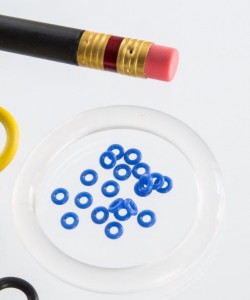Designing MicrOrings™ with inner diameters less than 1 mm and cross sections less than 1 mm poses a unique challenge: material selection. Unlike larger rubber designs with ample rubber mass, small parts have minimal mass, introducing potential risks to the design.
Ozone and UV
Certain polymers with unsaturation in their polymer backbone can prematurely fail in Ozone or UV environments. Think of old rubber bands cracking over time. Ozone, either natural or from electronics, and UV, used for purification or in systems with high-intensity lights, can penetrate thin rubber quickly. Choosing rubbers with strong ozone and UV protection is key.
- For systems without oil, EPDM is a good choice, with peroxide-cured EPDM being better for electronics.
- HNBR is preferable for oil exposure, while FKM and fluorosilicone offer excellent oil and ozone resistance.
- Silicone is versatile, providing oil resistance for splash applications and resisting high ozone and UV.
Gas and Vapor Permeation
Sealing gas or vapor applications requires giving attention to permeation resistance. Rubber mass significantly affects gas permeation, and in MicrOrings™, the lack of mass makes material selection critical.
- Silicone has high permeability
- Butyl has relatively low permeability for most gasses.
Check permeability for critical systems with long-term exposure. EPDM is ideal for water applications, Butyl for air or carbon dioxide, and FKM for fuel vapors.
Chemical Resistance
Rubber’s chemical resistance is indicated by volume swell when exposed to liquids or gasses. While MicrOrings™ have limited mass, picking the right polymer for fluid or vapor exposure is crucial. NBR and FKM are suitable for fuels and oils, EPDM for brake fluids and water, and Silicone for less aggressive acids.
Considerations
As MicrOrings™ find applications in smaller sealing designs, material selection is as crucial as groove design. Limited inventory compared to standard sizes means not all materials may be available. Trade-offs exist, and Apple Rubber’s Design Engineers can guide your decisions. In some cases, a specific material may not be the best choice, but for short-term or single-use applications, it may still suffice.
